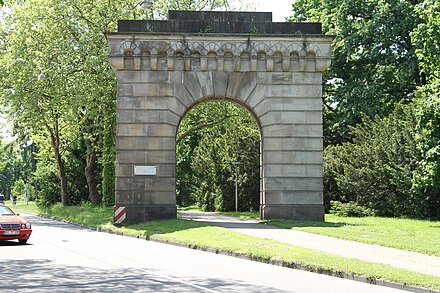
The German revolutions of 1848–49, the opening phase of which was also called the March Revolution, were initially part of the Revolutions of 1848 that broke out in many European countries. They were a series of loosely coordinated protests and rebellions in the states of the German Confederation, including the Austrian Empire. The revolutions, which stressed pan-Germanism, demonstrated popular discontent with the traditional, largely autocratic political structure of the thirty-nine independent states of the Confederation that inherited the German territory of the former Holy Roman Empire.

The Frankfurt Parliament was the first freely elected parliament for all of Germany, elected on 1 May 1848.
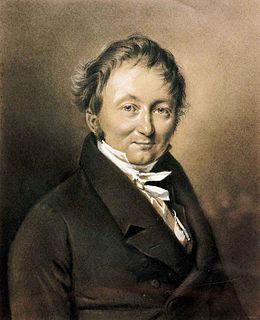
Karl Freiherr von Drais was a German forest official and significant inventor in the Biedermeier period.
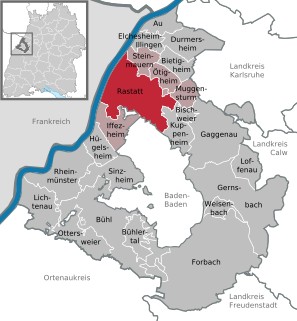
Rastatt is a town with a baroque core, District of Rastatt, Baden-Württemberg, Germany. It is located in the Upper Rhine Plain on the Murg river, 6 km (3.7 mi) above its junction with the Rhine and has a population of around 50,000 (2011). Rastatt was an important place of the War of the Spanish Succession and the Revolutions of 1848 in the German states.
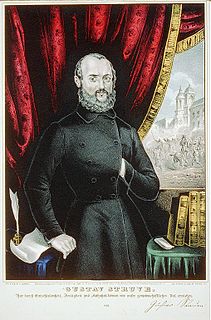
Dr. Gustav Struve, known as Gustav von Struve until he gave up his title, was a German surgeon, politician, lawyer and publicist, and a revolutionary during the German revolution of 1848-1849 in Baden Germany. He also spent over a decade in the United States and was active there as a reformer.

Bundesautobahn 5 is a 445 km (277 mi) long Autobahn in Germany. Its northern end is the Hattenbach triangle intersection (with the A 7. The southern end is at the Swiss border near Basel. It runs through the German states of Hessen and Baden-Württemberg and connects on its southern ending to the Swiss A 2.

The Badnerlied is the unofficial hymn of the former state of Baden, now part of Baden-Württemberg.

The Grand Duchy of Baden was an independent state in what is now southwestern Germany until the creation of the German Empire in 1871. It had its own state-owned railway company, the Grand Duchy of Baden State Railways, which was founded in 1840. At the time when it was integrated into the Deutsche Reichsbahn in 1920, its network had an overall length of about 2,000 kilometres (1,200 mi).
Gustav Nikolaus Tiedemann was a German soldier who joined the revolutionaries during the Revolutions of 1848 in Germany, eventually becoming the commander of the last holdout of the revolution, the fortress at Rastatt.

Karl Friedrich Nebenius was a Baden minister and author of their 1818 constitution.
Under the term of the 1815 Peace of Paris, France was obliged to pay for the construction of a line of fortresses to protect the German Confederation against any future aggression by France. All fortresses were located outside Austria and Prussia — the two biggest, bickering powers of the Confederation.

The Palatine uprising was a rebellion that took place in May and June 1849 in the Rhenish Palatinate, then an exclave territory of the Kingdom of Bavaria. Related to uprisings across the Rhine River in Baden, it was part of the widespread Imperial Constitution Campaign (Reichsverfassungskampagne). Revolutionaries worked to defend the Constitution as well as to secede from the Kingdom of Bavaria.
The Battle of Rinnthal was the heaviest battle of the Palatine uprising and took place on 17 June 1849 near Rinnthal in the Annweiler valley in Europe. The revolutionary troops under August Willich tried in vain to halt the advance of Prussian troops on Landau.
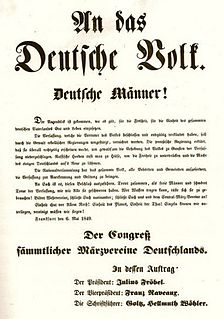
The Imperial Constitution campaign was an initiative driven by radical democratic politicians in Germany in the mid-19th century that developed into the civil warlike fighting in several German states known also as the May Uprisings (Maiaufstände). These conflicts against the counter-revolutionaries began in May 1849 and varied in length and intensity depending on the region. Some lasted until July that year. They marked the end phase of the popular and nationalist March Revolution that had started a good year before in March 1848.
The VIII Army Corps was a mixed corps of the army of the German Confederation, which was made up of contingents from Württemberg, Baden and Hesse. Until 1830 contingents from Hohenzollern-Sigmaringen, Hohenzollern-Hechingen and Liechtenstein also belonged to this corps.

The Storming of Freiburg took place on 24 April 1848 during the Baden Revolution. Units of the VIII Army Corps of the German Confederation stormed the town of Freiburg im Breisgau, which was occupied by republican volunteers (Freischärlern).
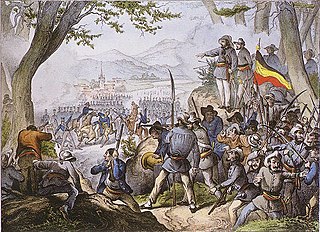
The Battle on the Scheideck, also known as the Battle of Kandern took place on 20 April 1848 during the Baden Revolution on the Scheideck Pass southeast of Kandern in south Baden in what is now southwest Germany. Friedrich Hecker's Baden band of revolutionaries encountered troops of the German Confederation under the command of General Friedrich von Gagern. After several negotiations and some skirmishing a short battle ensued on the Scheideck, in which von Gagern fell and the rebels were scattered. The German Federal Army took up the pursuit and dispersed a second revolutionary force that same day under the leadership of Joseph Weißhaar. The Battle on the Scheideck was the end of the road for the two rebel forces. After the battle, there were disputes over the circumstances of von Gagern's death.

Friedrich Wilhelm Graf von Bismarck was a German lieutenant general, diplomat and military writer. He wrote several major military-political works and military histories, which were very pro-Napoleon.










